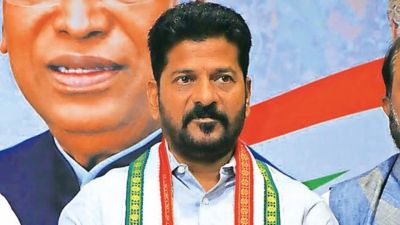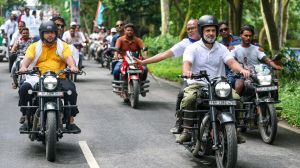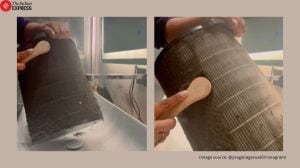Aishwarya Khosla is a journalist, currently serving as Deputy Copy Editor at The Indian Express. Her writings examine the interplay of culture, identity, and politics. She began her career at the Hindustan Times, where she covered books, theatre, culture, and the Punjabi diaspora. Her editorial expertise spans the Jammu and Kashmir, Himachal Pradesh, Chandigarh, Punjab and Online desks. She was the recipient of the The Nehru Fellowship in Politics and Elections, where she studied political campaigns, policy research, political strategy and communications for a year. She pens The Indian Express newsletter, Meanwhile, Back Home. Write to her at aishwaryakhosla.ak@gmail.com or aishwarya.khosla@indianexpress.com. You can follow her on Instagram: @ink_and_ideology, and X: @KhoslaAishwarya. ... Read More
‘Finest specimen of Hindustani culture’: From Saadat Manto to Ismat Chughtai, Urdu writers you must read and books you shouldn’t miss
Once the language of poets, revolutionaries, and common folk, Urdu remains a symbol of the Ganga-Jamuni tehzeeb — a syncretic tradition that transcends religious and geographical binaries.
 Manto's minimalist prose exposes the absurdity of violence with brutal clarity. (Express archive photo by Khatir Ghaznavi)
Manto's minimalist prose exposes the absurdity of violence with brutal clarity. (Express archive photo by Khatir Ghaznavi)In a landmark decision, the Supreme Court on April 15 upheld the use of Urdu on municipal signage in Maharashtra, describing it as “the finest specimen of Hindustani culture”, as Indian as Hindi or Marathi. Once the language of poets, revolutionaries, and common folk, Urdu remains a symbol of the Ganga-Jamuni tehzeeb — a syncretic tradition that transcends religious and geographical binaries.
To truly experience Urdu, one must journey through its rich literature.
Here are some of the most iconic writers of the language and essential works available in translation that everyone ought to read.
📌 Saadat Hasan Manto (1912-1955): The unflinching chronicler
Sadaat Hasan Manto, is one of the best known and prolific Urdu writers. His oeuvre includes 22 collections of short stories, a novel, five series of radio plays, three collections of essays and two collections of personal sketches. He is best known for his Partition stories, including Toba Tek Singh and Khol Do. His minimalist prose exposes the absurdity of violence with brutal clarity. Charged with obscenity six times for writing about sex workers and societal hypocrisy, Manto famously retorted: “If you cannot bear these stories, the society you live in is unbearable.”
📌 Ibn-e-Insha (1927–1978): The master of satire
Humorist and poet Ibn-e-Insha was a master of satire and social commentary. Born in Punjab, he became one of Urdu’s most celebrated writers. His Urdu Ki Aakhri Kitaab (The Last Book of Urdu) is a parody of textbooks, mocking rigid education systems while showcasing Urdu’s lyrical beauty. Beyond humor, Ibn-e-Insha was a prolific travel writer, documenting his journeys in Duniya Gol Hai (The World is Round). His ghazals, such as “Insha Ji Uttho“, remain timeless. His works—ranging from poetry to essays — reflect a deep love for language and culture.
📌 Shamsur Rahman Faruqi (1935–2020) : The architect of modern Urdu criticism
Shamsur Rahman Faruqi is known for revolutionising Urdu literary criticism. His magnum opus, The Mirror of Beauty (Kai Chand Thay Sar-e-Aasmaan), is a richly detailed historical novel set in 19th-century Delhi, blending romance, politics, and philosophy. Faruqi’s scholarly work on classical poets such as Mir Taqi Mir and Ghalib redefined Urdu literary analysis. Through his journal Shabkhoon, he nurtured new voices while championing traditional storytelling forms such as dastans. His legacy lies in bridging classical and modern Urdu literature with unparalleled depth.
📌 Qurratulain Hyder (1927–2007): The grande dame of Urdu fiction
Qurratulain Hyder is often regarded as Urdu’s greatest novelist. Her masterpiece, Aag Ka Darya (River of Fire), spans centuries—from ancient India to post-Partition South Asia—exploring cultural continuity amid upheaval. Hyder’s prose is lush and layered, weaving history with personal narratives. Works like Patjhar Ki Awaz (The Sound of Falling Leaves) and Mere Bhi Sanamkhane further cement her reputation as a literary giant. A recipient of the Jnanpith Award, she remains indispensable for understanding Urdu’s narrative richness.
📌 Premchand (1880-1936): The chronicler of rural India
Though primarily known for his Hindi works, Munshi Premchand, also known as Nawab Rai (1880–1936) began his literary career in Urdu. His stories — Kafan, Shatranj ke Khiladi, and Idgah — capture rural India’s social realities with unflinching honesty. Premchand’s early Urdu collection, Soz-e-Watan (The Dirge of the Nation) grapples with the concept of nationalism. A pioneer of socially conscious literature, Premchand’s Urdu writings remain foundational.
📌 Ismat Chughtai (1915-1991): The voice of Urdu feminism
Ismat Chughtai , the fiery Urdu writer from Badaun in Uttar Pradesh, revolutionised Indian literature with her unflinching portrayals of female desire and social hypocrisy. A contemporary of Manto, she shattered taboos through works such as Lihaaf (The Quilt, 1942)—a groundbreaking story about homoeroticism and the suppression of a woman’s sexual desires that landed her in court for obscenity. Chughtai’s writing—from the semi-autobiographical novel Tedhi Lakeer (The Crooked Line) to stories such as Ghungat—exposed the oppression of women in conservative societies.
📌 Patras Bokhari (1898–1958): The king of Urdu humour
Syed Ahmed Shah “Patras” Bokhari was a diplomat, broadcaster, and one of Urdu’s finest humourists. His essays, collected in Patras Kay Mazameen, are a masterclass on dry wit and keen observations on human nature. A professor at Government College, Lahore, Bokhari mentored luminaries such as Faiz Ahmed Faiz. His radio broadcasts and satirical writings, such as Urdu Ki Aakhri Kitaab (a playful nod to Ibn-e-Insha), showcase his linguistic brilliance. His legacy endures in both literature and broadcasting.






- 01
- 02
- 03
- 04
- 05


























